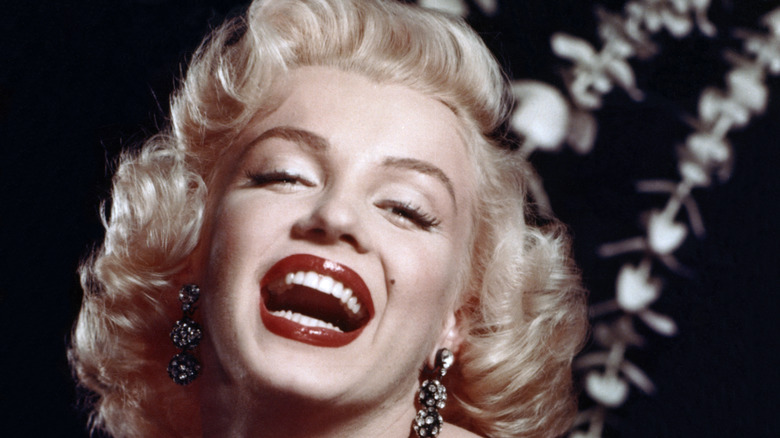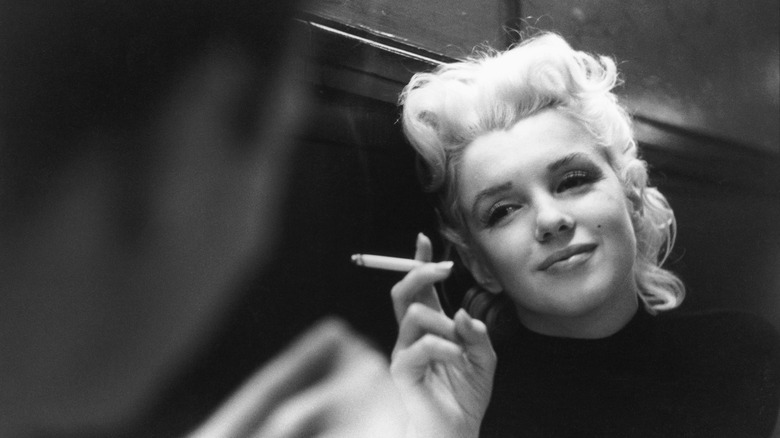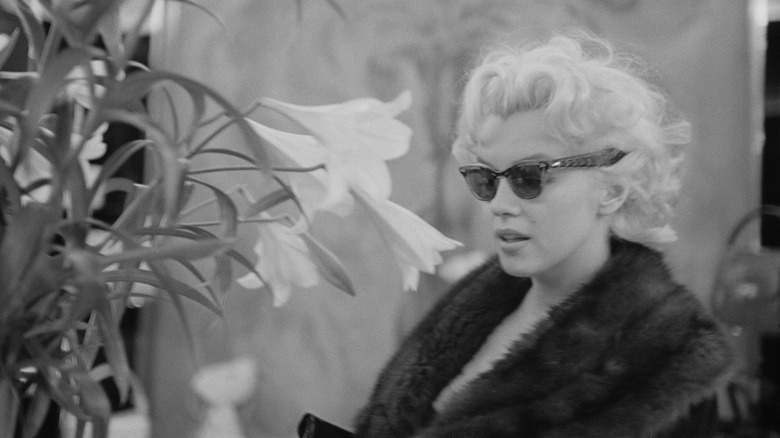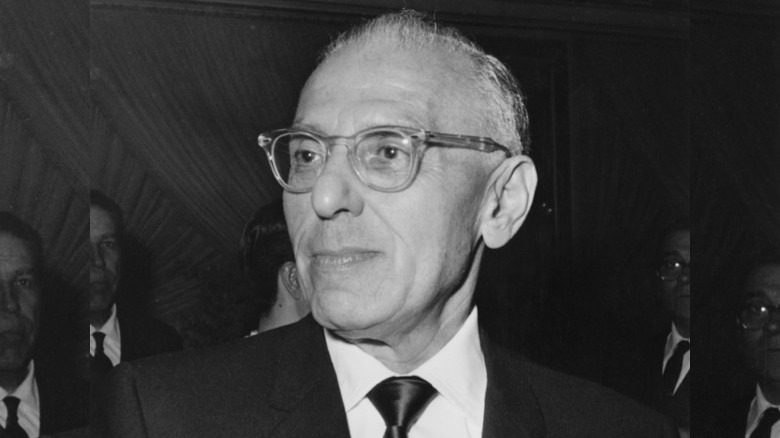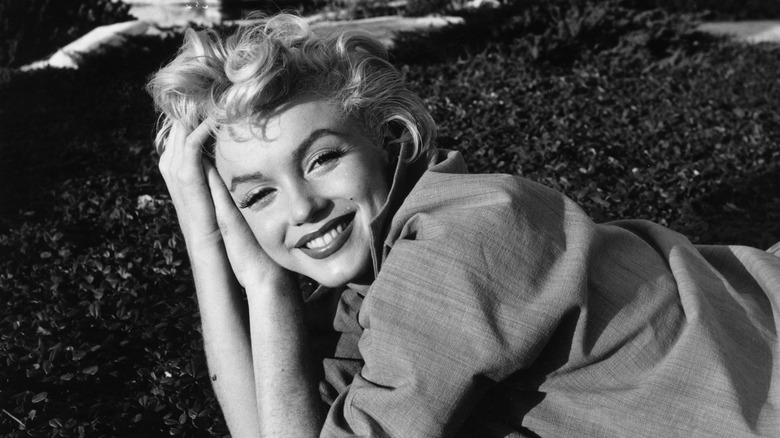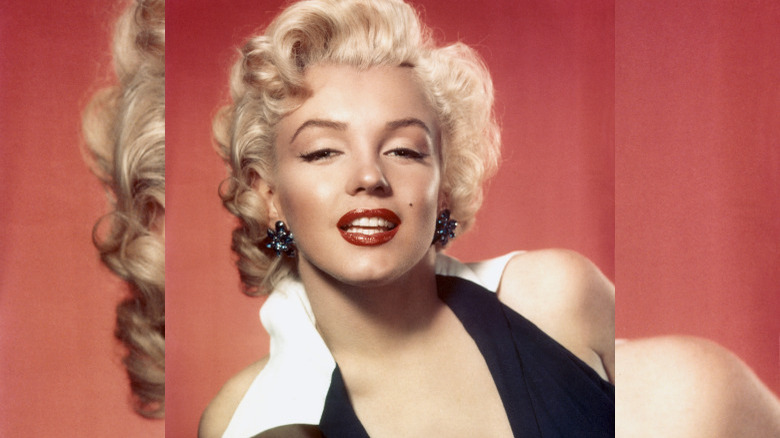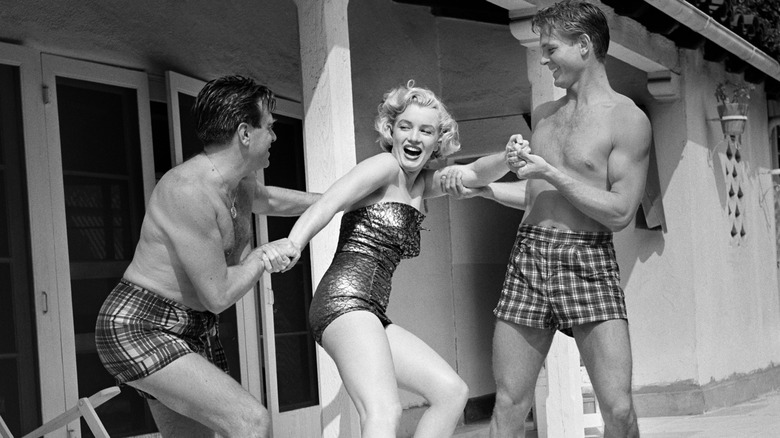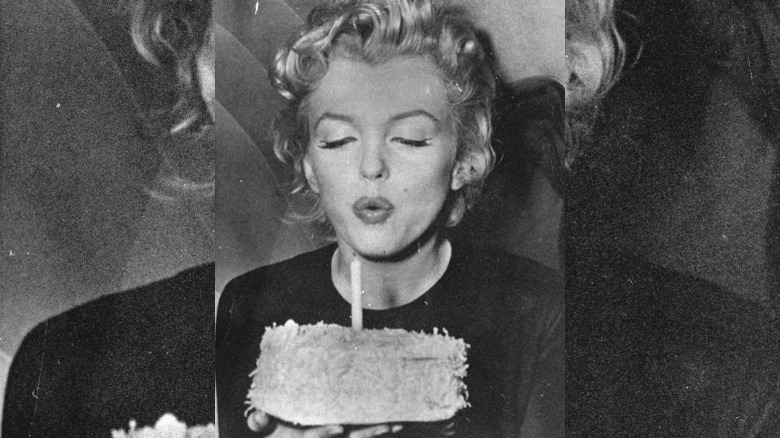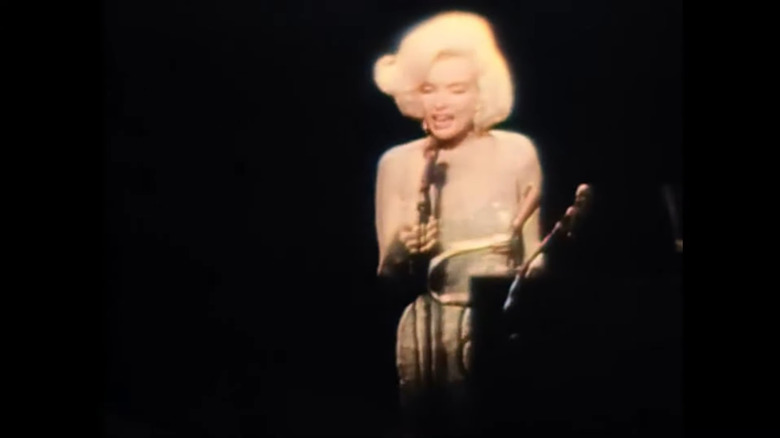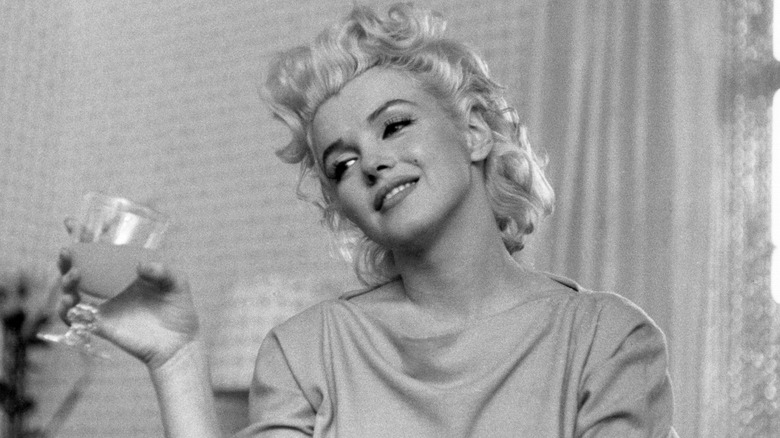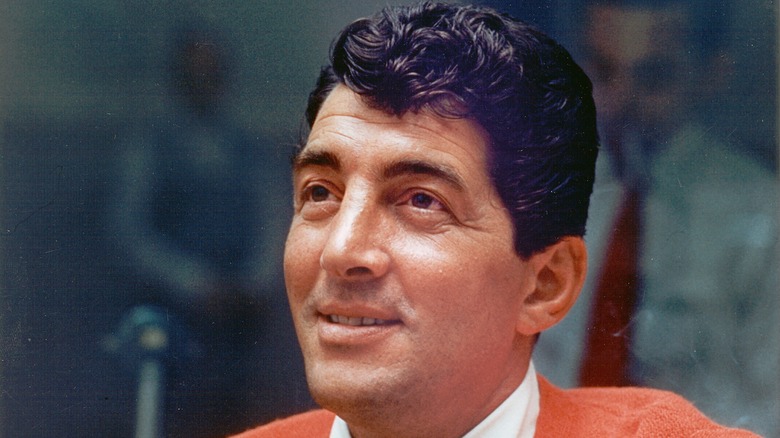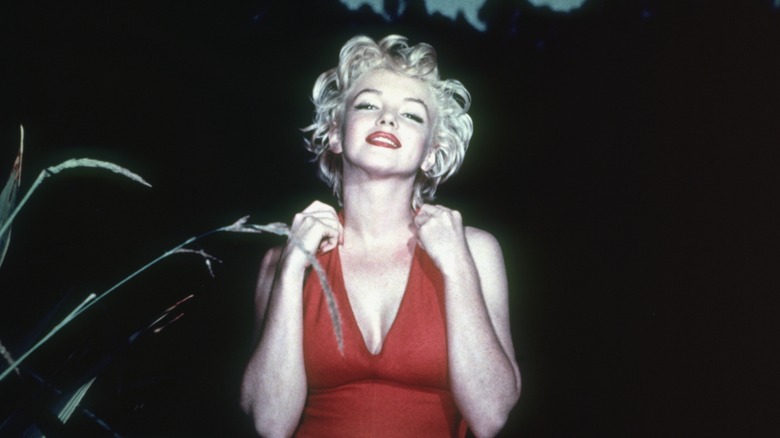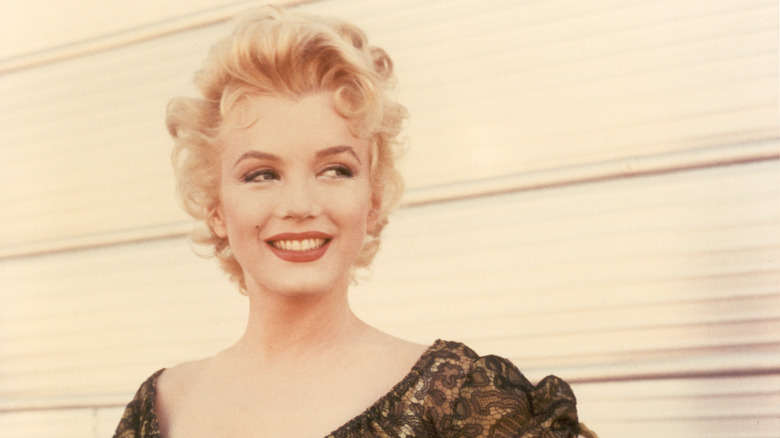What Marilyn Monroe's Last Movie Was Like Before She Died
Marilyn Monroe's film career spanned only a little longer than a decade. She appeared in just 29 films and died tragically at only 36 years old. And yet her impact on pop culture has been massive, and she remains an iconic sex symbol six decades after her death. More than just a pretty face, Monroe had real talent — and has been seen in recent years as crucial to both the sexual revolution of the 1950s and 1960s and the burgeoning feminist movement.
Monroe fascinates people, as do her films — particularly her later work when she was struggling with physical and mental health issues and a bad professional reputation. Many people assume "The Misfits," her 1961 film with Clark Gable, was her last film role, but that was actually just her final film to be released. The last film Monroe worked on was actually 1962's "Something's Got to Give." Just like everything else associated with Monroe, her final film remains obscured by mystery and controversy — especially because she had a public dispute with the studio that was resolved just a few days before her death. The truth has been clouded by the lawsuits and public relations work, but, over time, the story behind "Something's Got to Give" has slowly clarified. Here's what Marilyn Monroe's last movie was like before she died.
The set was strained from the beginning
According to The Independent, "Something's Got to Give" was a remake of "My Favorite Wife," a 1940 comedy. The story is silly: A woman is stranded on a deserted island with a stranger for five years, and her husband (Dean Martin) assumes she has died, and so he remarries. When she is finally rescued, the poor husband has two wives and struggles to keep his life afloat.
Author Keith Badman notes in his book "The Final Years of Marilyn Monroe" that the film was continuously delayed, eventually seeing the start of production pushed from January to March 1962 due to problems finalizing the script. Delays mounted, and 20th Century Fox, the studio making the film, began to worry about getting the film completed in order to generate some much-needed revenue.
But the film's director, the legendary George Cukor, didn't get the memo. According to Classic Movie Hub, he spent time and money having his own house replicated as the set for the film and was happy to waste time on unimportant details like getting a dog to bark on cue. As a result, the set was a pressure cooker with studio execs pushing for a fast release while the schedule slipped further and further behind, putting everyone on edge.
Monroe hadn't worked in a year
Marilyn Monroe was a huge star, but she joined the production of "Something's Got to Give" under several dark clouds. For one thing, as noted by The Independent, she hadn't worked — or even been on a film set — in a year. The outlet reveals that producer Henry Weinstein described her as afraid to stand in front of the camera. As Biography explains, the previous year had been a rough one for Monroe. She'd gone through a divorce from Arthur Miller, spent some time in a psychiatric hospital to be treated for depression, and had her gallbladder removed — a surgery that Marie Clare reports left a very large and noticeable scar across her belly, something that made the sex symbol extremely self-conscious.
The result of all that stress — physical, mental, and emotional — was a diminished movie star who was thinner than she ever had been before. Ironically, the studio saw this as a positive point since they had concerns about hiring the 35-year-old bombshell. And the actress had lost confidence in her own judgment. In his book "The Final Years of Marilyn Monroe," author Keith Badman notes that Monroe repeatedly rejected the script for "Something's Got to Give" because she was acutely aware that she'd made poor choices in the past and no longer trusted her instincts. Monroe simply wasn't ready to go back to work.
Monroe was ill throughout filming
After signing on to make "Something's Got to Give," The Independent reports that Marilyn Monroe fell ill almost immediately, and missed day after day of work. She'd spent time over the previous year in a psychiatric hospital being treated for depression and had lost significant weight after her gallbladder surgery, which left her in poor health. She provided doctor's notes that claimed she was suffering from various ailments, including high fevers, sinusitis, and viral infection. Worse, when she did appear on set, she often locked herself in her trailer and had to be coaxed out to film her scenes. Vogue notes that her stress levels were so high that a childhood stutter returned, making it difficult for her to recite her lines.
According to the Los Angeles Times, director George Cukor initially tried to accommodate Monroe's health issues by filming around her. But this could only compensate for an absent star to a certain extent. In the first 30 days of filming, Monroe missed 17 days. Producer Henry Weinstein reported that he frequently found Monroe throwing up before having to perform her scenes — and once even stumbled onto her unconscious from a barbiturate overdose. He suggested that the studio stop the film in light of Monroe's fragile health, but the studio — under increasing financial stress — refused. Monroe was working in an environment where everyone seemed to be hostile to her needs and obvious mental and physical health problems.
If you or anyone you know is struggling with addiction issues, help is available. Visit the Substance Abuse and Mental Health Services Administration website or contact SAMHSA's National Helpline at 1-800-662-HELP (4357).
The studio was desperate
As reported by The Independent, when "Something's Got to Give" went into production in 1962, the studio was also making "Cleopatra," the epic bomb starring Elizabeth Taylor and Richard Burton. That film eventually had a budget estimated at about $44 million, according to Variety — a staggering sum in 1962 and equivalent to about $415 million in today's dollars. According to author Keith Badman in his book "The Final Years of Marilyn Monroe," another project, "The Longest Day," was also costing a lot more than the studio had planned — about $10 million, or close to $100 million in today's money.
The cost overruns on these movies had studio executives in a panic, and "Something's Got to Give" was seen as a quick way to make some fast money to keep the studio away from bankruptcy. As the shooting schedule fell behind due to Monroe's absences and illnesses, tensions on the set began to rise. Studio executives couldn't go after "Cleopatra" star Elizabeth Taylor, who was paid a record $1 million to appear in the film, but they could, and did, view Monroe and her $100,000 paycheck as a scapegoat for the studio's problems. "Something's Got to Give" was never completed, but "Cleopatra" was released in 1963, and despite strong ticket sales, it lost enormous amounts of money due to the ballooning budget.
The script changed every day
In "The Final Years of Marilyn Monroe," Keith Badman wrote that Monroe was initially reluctant to accept the role in "Something's Got to Give" because she didn't like the script. Monroe didn't have contractual script approval — meaning the studio didn't have to take any of her suggestions — but producer Henry Weinstein noted that it didn't matter. If Monroe didn't like something in the script, she was legendary for simply not showing up until it was changed. So the studio worked with its star to revise the script over and over again until she was satisfied.
After production began, however, the script continued to change on an almost daily basis. As noted by film historian Michelle Vogel in her book, "Marilyn Monroe: Her Films, Her Life," the producers soon began distributing new script pages on colored paper so the cast and crew would know what had changed, but soon switched to sending Monroe standard white pages because the color system confused her. As a result, Monroe would often discover that after working hard to learn her new lines, those lines had changed again when she arrived on set.
This undoubtedly contributed to the image of Monroe as a poor actress who continuously flubbed her lines — but it's also a clear sign of the chaos that she and everyone else was dealing with on the film set.
Monroe had one last triumph
In his book "Marilyn Revealed," author Ted Schwartz notes that by the time Marilyn Monroe began filming "Something's Got to Give" at the age of 35, she was already considered old for her sex symbol role. As reported by The Independent, the producers were very conscious of what Monroe brought to the film — they weren't concerned about her performance but were very, very concerned about her appearance. When she arrived on set, the studio executives were pleased to see how thin their lead actress had become after dealing with health issues.
Monroe was well aware that her status as a sex symbol mattered — and depended entirely on her physical appearance. This is why the swimming pool scene in the film has become iconic despite the fact that the film was never released. In the scene, Monroe's character, Ellen, goes skinny dipping in her husband's house in order to entice him to come down to her. Monroe was given a flesh-colored swimsuit for the scene, but decided impulsively to remove it — and actually swam naked and invited photographers to document the moment.
As Vanity Fair makes clear, the nude scene wasn't erratic behavior — it was a calculated gambit. Monroe knew that she had competition — most notably Elizabeth Taylor, who was being paid ten times as much to star in "Cleopatra." When she invited photographers to capture the moment, she stipulated that when they published the photos, Taylor couldn't be mentioned in the same issue.
They made Monroe work on her birthday
You might think that as a star of Marilyn Monroe's caliber, her treatment on the set of "Something's Got to Give" must have been great. For example, if you're a big star and your birthday rolls around while you're filming a movie, you might assume everyone throws you a big party.
Think again. Classic Movie Hub reports that Monroe's stand-in, Evelyn Moriarty, did think to plan a surprise party for Monroe. According to author Gary Vitacco-Robles in his book "Icon: The Life, Times and Films of Marilyn Monroe," Moriarty collected $7 from the cast and crew and purchased a sheet cake from Humphrey's Bakery, decorated in honor of Monroe's famous nude swimming scene and sparklers.
If that isn't exactly what you might imagine for a movie star like Monroe, it gets worse. Not only did director George Cukor order that the cake be hidden away and the party held off until after production had wrapped — so he could get a full day's work from Marilyn — as author Lois Banner notes in her book "Marilyn," as a final insult to their star, Cukor and the studio executives didn't attend the party when it was finally allowed to happen.
Kennedy's birthday added to the chaos
There are a handful of iconic moments that are associated with Marilyn Monroe — her dress blowing up around her in "The Seven Year Itch," for example, or her singing "Diamonds are a Girl's Best Friend" in "Gentleman Prefer Blondes." One moment that everyone thinks of is her performance of "Happy Birthday" at Madison Square Garden in honor of President John F. Kennedy on May 19, 1962. Her breathy, sensual performance of the song solidified her sexy image for all time. As noted by Biography, the event also spurred fresh rumors that Monroe and the President were having an affair.
But this famous moment made the set of "Something's Got to Give" — which was already chaotic — even worse. As author Michelle Vogel notes in her book "Marilyn Monroe: Her Films, Her Life," 20th Century Fox had given Monroe permission to attend the event back at the beginning of the year when Monroe signed contracts for the film. But Monroe had missed so much work due to frequent illnesses that studio executives were outraged that Monroe, too sick to work, was apparently healthy enough to attend a party on the other side of the country.
According to The Independent, the director of the film, George Cukor, was "furious" about the appearance. When Monroe arrived in New York, she was informed that the studio had issued a breach of contract notice, and from that point on, tension on the set was palpable.
Monroe was fired after calling in sick again
After Marilyn Monroe sang "Happy Birthday" to President John F. Kennedy, tensions on the set were running high. Monroe had frequently been absent from work due to various health issues and claimed illness on a constant basis, so the idea that she felt well enough to jet off to New York for a party seemed incredible.
The studio hit her with a breach of contract notice for the stunt, according to author Michelle Vogel in her book "Marilyn Monroe: Her Films, Her Life." And in "Marilyn Monroe: Private and Confidential," author Michelle Morgan notes that Monroe continued to call in sick despite the rising tension, refusing to work when co-star Dean Martin had a cold. On June 2, just a day after turning 36, Monroe once again refused to show up to work and then called in sick again on June 4, prompting co-star Dean Martin to storm off the set in frustration.
As reported by The Independent, that was the last straw. After threatening Monroe with a lawsuit, on June 7, 1962, the studio announced that Monroe had been fired due to what it described as "spectacular absenteeism." As reported by Vogel, producer Henry Weinstein calculated that over the course of 32 days of production on the film, Monroe had only shown up for work 12 days. Worse, when she did show up, she wasn't exactly efficient, only getting the equivalent of four days' work done in that time.
Lawsuits flew
Firing a major star from a film that had been in production for 32 days is, as you might imagine, pretty messy. The lawsuits began to fly fast and furious.
Michelle Morgan wrote in her book "Marilyn Monroe: Private and Confidential," the film studio immediately sued Monroe for breach of contract, asking for $500,000 in damages. But that was just the tip of the iceberg. The Independent reports that Monroe's co-star, Dean Martin, refused to work with a different actress on the film, stating that part of the reason he'd agreed to work on the movie was because of Monroe. According to author Michelle Vogel, Martin's refusal to get back to work prompted his co-star, Cyd Charise, to sue him for $14,000 in damages — and the studio also sued him for $500,000.
As time went on, the studio came to view Martin as the real problem, claiming he'd verbally agreed to consider replacement actresses and then reneged. Ultimately the studio sued Martin for an astounding $3,339,000 — more than $30 million in today's money. Martin casually counter-sued, demanding $6,885,000. At the same time, the studio increased the damages they were seeking from Monroe to $750,000. In the end, none of these suits went anywhere, and no one won any damages from anyone.
Fox re-hired Monroe with a bonus
According to The Independent, Monroe was fired from the film "Something's Got to Give" on June 7, 1962, for her chronic absenteeism. According to Michelle Vogel in "Marilyn Monroe: Her Films, Her Life," Monroe was re-hired less than a month later, on August 1, 1962. She wasn't just re-hired — she was re-hired with a long list of bonuses.
First and foremost, she got an immediate raise from $100,000 to $250,000 to complete work on the film. Second, she was also given a $1 million contract for two more films, raising her salary to $500,000 per film. And possibly most important for Monroe, director George Cukor was replaced with Jean Negulesco. After being fired by a furious studio, Monroe was triumphant.
Why the studio made such an abrupt about-face remains under speculation. Many believe that co-star Dean Martin's refusal to consider working with any other actress had a lot to do with it. Vogel suspects that the studio simply realized that for all her flaws, Monroe was a unique box office attraction who was literally irreplaceable. Whatever the reasons, on August 1, 1962, Monroe was at a professional high point. She never got to enjoy it. Three days later, on August 4, 1962, she was dead.
Filming was never completed
After Marilyn Monroe's death, 20th Century Fox shut down production on "Something's Got to Give" — taking a loss of about $2 million, according to author Peter Lev. In his book "The Immortal Marilyn," Frank Tropea notes that the studio locked away all of the footage from the production and claimed for years that Monroe's appearance and performance were too bad to be seen. For decades this was the story of the film: A troubled production ruined by a star whose mental and physical state prevented her from giving a decent performance.
But in 2001, the studio finally released an edited version of the usable footage from the shoot, amounting to about 30-40 minutes — and the results were eye-opening. As Tropea notes, Monroe fit the part of a classic Hollywood beauty in her scenes, and according to The Independent, a review of the nine hours or so of raw footage from the shoot shows Monroe to be professional and patient. And her performance is strong, showing no signs of the on-set turmoil or her physical ailments.
Author Michelle Vogel notes in her book "Marilyn Monroe: Her Films, Her Life" that 20th Century Fox salvaged what it could from the debacle by recasting the film with James Garner and Doris Day and changing the title to "Move Over, Darling." That film was a decent hit for the studio, but the film is largely forgotten today — unlike Marilyn Monroe.
